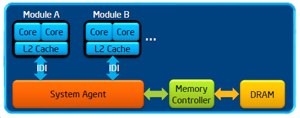With its new Silvermont architecture, it looks like Intel has finally leaped forward in mobile. But whether it can ward off ARM’S upcoming 64-bit ARMv8 processors is another story.
Intel’s announcement this week of its 22-nanometer (nm) Silvermont revision of the Intel Atom came with some remarkable claims. Silvermont is three times faster and five times more power efficient than existing Atoms, says the chipmaker. More importantly, Intel says its quad-core Silvermont-based “Bayfield” system on chip (SoC), due in tablets by year’s end, will offer twice the performance and 4.3 times lower power consumption than quad-core ARM SoCs. Dual-core Silvermont “Merrifield” SoCs for smartphones, due by year’s end or early 2014, are said to be 1.6 times faster and 2.4 times more power efficient than quad-core ARM SoCs.
 The power and performance gains were achieved by advancing from the 32nm Saltwell Atom architecture to the 22nm process and Tri-Gate “3D” non-planar transistor technology borrowed from the latest “Ivy Bridge” Core processors. Further gains stem from improved out-of-order execution and power management, a faster GPU, and enhanced coordination among up to eight cores. (See this LinuxGizmos report for more technical details.)
The power and performance gains were achieved by advancing from the 32nm Saltwell Atom architecture to the 22nm process and Tri-Gate “3D” non-planar transistor technology borrowed from the latest “Ivy Bridge” Core processors. Further gains stem from improved out-of-order execution and power management, a faster GPU, and enhanced coordination among up to eight cores. (See this LinuxGizmos report for more technical details.)
The improved power consumption, which is due primarily to Tri-Gate, is especially notable since the 32nm Saltwell-architecture “Medfield” Atom demonstrated greatly improved battery life. The Medfield, which has appeared in a few Android phones including Motorola’s Razr i, still trailed ARM in power consumption, but came fairly close.
Intel even appears to have an answer for ARM’s innovative big.LITTLE architecture, which debuted in Samsung’s eight-core Exynos Octa-Core. While big.LITTLE divies up tasks among faster Cortex-A15 cores and more power-efficient Cortex-A7 cores, Intel claims that Silvermont’s new multicore framework enables similar sharing without the complexity of mixing different core types.
Meandering Toward Mobile
Until Silvermont, Intel has taken a rather leisurely course toward mobile. When the first 45nm “Bonnell” Atoms shipped in 2008, the iPhone was still new, the first Android phones had yet to ship, and tablets were thick, pricey, and typically Windows-based. Intel tried to promote the Atom via its Linux-friendly Mobile Internet Device (MID) form-factor. However, these extra-thick tablets with 5- to 7-inch resistive touchscreens proved unpopular with consumers. Nevertheless, the Atom managed to thrive on netbooks, and once that trend had ebbed, it was already well established on a range of increasingly Linux-based embedded devices that required better power efficiency than Core processors could provide.
ARM processors were even more power efficient, however, and the booming market for ARM-based smartphones and tablets spurred ARM SoCs to much faster speeds and even more power efficiency. Meanwhile, the sheer volume of Android and iOS sales helped lower costs.
While ARM chips evolved quickly, the Atom developed more slowly, especially when it came to power consumption. Few expected the recent market shift from notebooks to smartphones and tablets to occur as quickly as it did, but the signs were clear. By the time Intel ported Android to x86 and developed its 2GHz Medfield, the Atom was still trailing ARM in battery life and price, although it bested most devices on performance.
20nm ARMv8 SoCs Due in 2014
By year’s end, when the first Silvermont tablets appear, the Atom will have vaulted ahead of its ARM competition. It’s unclear how long that advantage will last. After all, ARM is expected to move from 28nm to 20nm fabrication on the Cortex-A15 and 64-bit, ARMv8 Cortex-A57 designs by 2014. The micro-server and desktop-targeted A57 will support a big.LITTLE arrangement with the similarly ARMv8-based Cortex-A53 smartphone/tablet SoC. Both should advance to 16nm fabrication by 2015 or 2016.
Still, even if Silvermont falls short of its claims, ARM SoC vendors must be cringing at the news that Intel plans to introduce a new Atom architecture every year. In fact, Intel is already planning a 14nm Airmont design for 2014. Silvermont is particularly threatening to Qualcomm and Nvidia, which unlike Samsung, don’t have the luxury of populating a best-selling line of Android mobile devices with their own chips.
Assuming the Silvermont claims are close to being true — and that Intel can compete on price — the mobile market will undergo a significant shift. Windows 8 tablets could get a lease on life, and the Atom should significantly cut into ARM’s dominion of Android, likely resulting in lower prices for users. As long as Samsung sits atop the Android heap, ARM should continue to dominate Android, but in the unlikely event that Samsung or Apple switch to the Atom, things could be very tough for ARM indeed.
Meanwhile, it’s all good news for Linux, which unlike Android or Windows — the other two platforms officially supported by Silvermont — is already equally at home in both the x86 and ARM worlds. Silvermont-based networking, automotive, and server SoCs are in the works, and although there are no details, Intel says CPU versions are in the pipeline, presumably aimed at embedded applications. What’s not to like?


